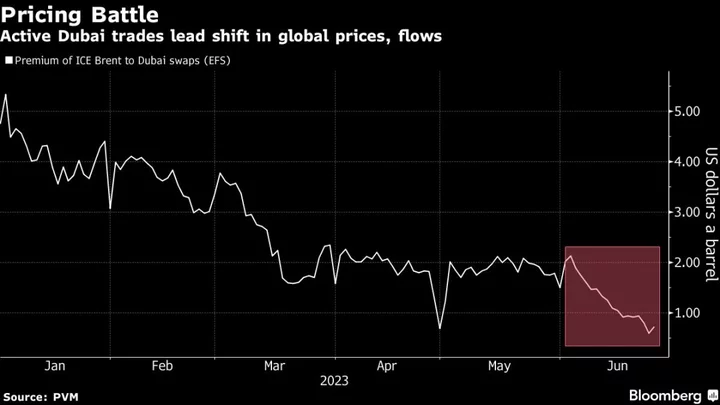Two giants in China’s oil and refining sector have taken the biggest opposing positions in Middle East crude trading in years, transforming global cargo flows and puzzling oil traders the world over.
Throughout this month, Dubai crude has fluctuated heavily, largely due to aggressive bidding and offering from the trading units of Chinese oil refiners, PetroChina Co and Sinopec. They’re respectively the nation’s biggest oil company and its top refiner. This has only intensified with time.
Public clashes between China’s state-owned behemoths are uncommon, and in this instance the firms’ activity in the main Middle East oil price benchmark is particularly peculiar because both are big refiners who should, in theory, be eager to obtain crude as cheaply as possible. Instead, PetroChina’s Hong Kong entity has been bidding — and purchasing cargoes as a result of its bids — while Sinopec’s Unipec has been offering and selling shipments.
Nobody replied to emails sent to PetroChina and Sinopec’s media departments seeking comment.
This month, more than a thousand derivatives contracts have traded in the vital pricing window that sets the Dubai price — close to triple the monthly average in 2023 and the biggest volume for years.
At least 10 other traders said the activity — surprising to all, given normal patterns for Chinese entities — made it harder to ascertain the true strength of the Middle East oil market, a pivotal part of the petroleum supply chain, as well as China’s state of recovery.
The price of Dubai oil forms the basis of almost all exports from the Middle East, including Saudi Arabia. That means any strength or weakness in the price of the grade translates directly to the affordability of oil purchases from across the region, and how many barrels flow from elsewhere in the world to Asia.
The surge has also likely helped to boost markets for oil that is similar to the types found in the Middle East. Norway’s Johan Sverdrup jumped by about $1 a barrel after Unipec purchased the grade.
Traders said changes in global cargo flows might not have taken place without the spike in Chinese activity.
In the futures market, Dubai is a far smaller contract than the likes of Brent and West Texas Intermediate. But in recent months Dubai open interest has picked up significantly — a sign of more position-taking.
Window Shopping
Normally, bids and offers on the Platts Dubai window are a reflection of companies’ view on the Middle East market. Traders can buy and sell partial contracts of Dubai crude on the window and get physical delivery of grades including Oman, Upper Zakum and Dubai after 20 transactions.
Unipec is aggressively offering partial Dubai contracts, derivatives that when combined allow traders to sell full cargoes of oil from the region. So far the company has delivered 41 cargoes — or 20.5 million barrels — to various buyers. PetroChina HK has bought 11.5 million barrels.
France’s TotalEnergies SE remains among the most active bidders alongside PetroChina. Total has also been selling cargoes in a parallel North Sea pricing window for much of this month.
Two Chinese giants previously went head-to-head in 2015 when a unit of China National United Oil Corp., parent company of PetroChina, bought 36 million barrels of Middle East Crude, mostly from Unipec.
Platts, a unit of S&P Global which operates the Dubai pricing window, said the trading activity is the biggest since 2015 and that the buying and selling of cargoes has been between a broad range of market participants. It added that Dubai prices have been boosted by a host of factors including OPEC production cuts and official selling price increases from Saudi Arabia, citing traders.
Read: Oil Trading Surges in Dubai Pricing Window on Unipec Selling
The impact of the trades on the rest of the world is already clear.
In early-June, Unipec’s aggressive selling signaled the company was reluctant to buy big volumes from the Middle East. Instead, it purchased supplies from the North Sea and US, lifting the cost of some grades priced against the Brent benchmark.
With Middle Eastern barrels now looking cheaper, it’s possible that Asian refiners may consider nominating less crude from Saudi Arabia next month, seeking more affordable alternative barrels instead, traders said. Cheaper spot cargoes have already prompted interest from China’s Rongsheng Petrochemical Co. and Taiwan’s Formosa Petrochemical Corp.,, underscoring the wide-reaching impact of the window battle.
Volatility too remains intense. Last week, spot differentials of Oman tripled and then retreated again. Traders said the move was centered around concerns that there might not be enough cargoes to match the volume of selling in the window, though continued sales in partials trading allayed those fears.
As most trading activity in Asia takes place over monthly cycles, it’s likely the positioning will end when contracts expire this week at the end of June.
Executives have been previously suspended from their jobs for facing big trading losses, most notably Unipec President Chen Bo in 2018.
--With assistance from Sharon Cho, Alex Longley and Alfred Cang.
(Updates 12th and 13th paragraph with details on window trades.)

